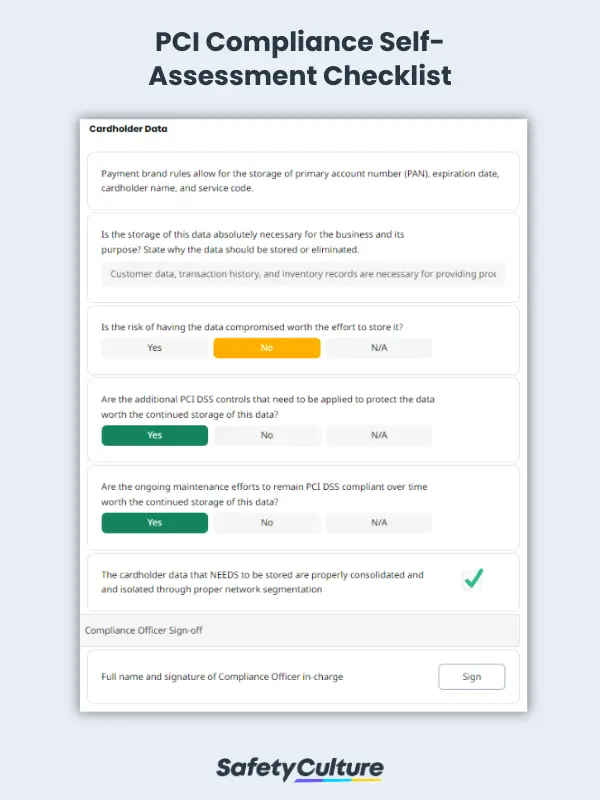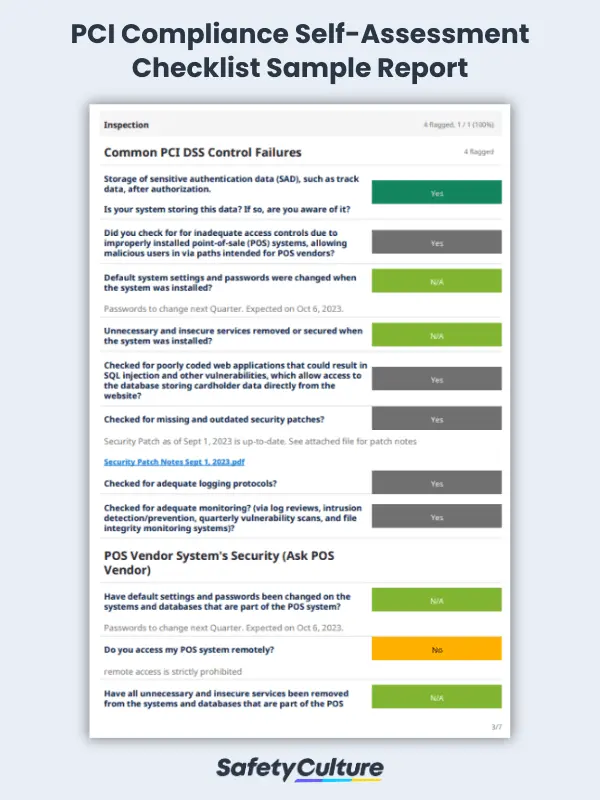What is a PCI Compliance Checklist?
A PCI compliance checklist is a comprehensive template, designed to meet the stringent standards set by the Payment Card Industry Data Security Standard (PCI DSS), plays an important role in ensuring that businesses handle payment card data securely and responsibly. The checklist comprises a structured set of guidelines, measures, and best practices that organizations must adhere to in order to maintain the integrity of their payment card transactions and protect their customers’ data from potential breaches.
Importance and Benefits
With the increasing prevalence of online transactions, most businesses and organizations are required to ensure the security of these data. This is where PCI compliance is a must, and utilizing a digital checklist comes into play. In this article, we’ll delve into the significance of PCI Compliance and explore the numerous benefits it brings to the table :
Building a Secure Network and Systems
One of the primary goals of PCI Compliance is to establish a secure network and systems within an organization. By adhering to a PCI Compliance checklist, businesses can systematically identify vulnerabilities and address them promptly. This includes implementing robust firewalls, encryption protocols, and access controls. Such measures not only protect cardholder data but also instill trust among customers.
Protecting Cardholder Data
Cardholder data is the lifeblood of many businesses, and safeguarding it is a legal and ethical obligation. PCI Compliance checklist emphasizes data protection through encryption and tokenization, rendering cardholder data unreadable to potential cybercriminals.
Managing Vulnerabilities
No system is entirely immune to vulnerabilities, and it’s crucial to have a mechanism in place to manage them effectively. PCI Compliance checklist advocates regular vulnerability scans and penetration testing.
Consequences
Failure to comply with PCI standards can have dire consequences for businesses. From financial penalties ranging at $5,000 up to $500,000 per PCI data security incident or breach, to damage to the reputation of the business. These fines can cripple a business financially and even lead to its closure in extreme cases. With the use of a comprehensive PCI compliance checklist, you will be able to proactively catch issues and prevent huge fines.
What to Include in a PCI Compliance Checklist
To establish a solid foundation of a PCI compliance checklist, let’s begin by understanding what PCI DSS entails. It encompasses a series of requirements and best practices that organizations must follow to protect cardholder information effectively :
Understand the PCI Data Security Standards (DSS)
The PCI Data Security Standard (DSS) serves as the rulebook for safeguarding customer payment data. It outlines a set of security requirements that you must adhere to. Think of it as a checklist within your checklist. A comprehensive understanding of the PCI DSS is fundamental to achieving compliance.
Ensure Network Security
Securing your network is important. Employ firewalls, encryption, and robust passwords to fortify your digital defenses. Regularly update your software and promptly address any identified vulnerabilities to prevent security breaches resulting from outdated systems.
Protect Cardholder Data
Protecting cardholder data is at the core of PCI compliance. Only retain essential cardholder information, and when stored, ensure it is encrypted. Adhere to the principle of data minimization—if you don’t need it, don’t keep it.
Continuous Monitoring and Testing
Routine monitoring and testing are akin to health check-ups for your network. Consistently observe your systems for any irregularities, conduct vulnerability assessments, and execute penetration tests to identify and mitigate weaknesses before they escalate.
Prepare and Review an Incident Response Plan
Despite proactive measures, incidents can occur. Therefore, have a well-defined incident response plan in place. Think of it as a contingency strategy for your digital environment, ready to be activated if needed.
How to Achieve PCI Compliance with a Checklist
Once the organization is familiar with the compliance regulations, it’s important to follow a thorough and streamlined process such as digital forms instead of the traditional paper based system. Here’s how you can use this checklist for a PCI compliance check :
- Enter basic information : Date, location, and who’s conducting the compliance check
- Assess common PSI DSS Control Failures. Review if security patches are up-to-date, logging protocols, and other vulnerabilities.
- Check POS vendors system’s security for any vulnerabilities.
- Review cardholder data protection by analyzing any vulnerabilities and storing capabilities. Check if storing or eliminating these sensitive data is necessary.
- Summarize the findings and provide recommendations and action points.
Frequently Asked Questions (FAQs)
The frequency of PCI compliance audits depends on several factors, but generally, they should be performed annually. This annual requirement is stipulated by the Payment Card Industry Data Security Standard (PCI DSS) and serves as a fundamental guideline for maintaining the security of your cardholder data environment (CDE).
While PCI compliance is a widely accepted standard for secure payment processing, there are alternatives to consider. Tokenization and end-to-end encryption (E2EE) are two significant alternatives. Tokenization replaces sensitive card data with unique tokens, reducing the risk associated with storing actual card numbers. E2EE encrypts payment data from point-of-entry until it reaches the payment processor, safeguarding it throughout the transaction process. Additionally, some organizations explore third-party payment processing services that handle the bulk of PCI compliance responsibilities, further minimizing their compliance burden.
Yes, small businesses that handle payment card data are typically required to comply with PCI standards. The specific level of compliance, however, depends on the volume of transactions they process annually. Small businesses fall under one of four PCI compliance levels, ranging from Level 4 (the lowest) to Level 1 (the highest), based on transaction volume. Non-compliance can result in data breaches, financial penalties, and damage to reputation, so it’s crucial for small businesses to assess their compliance obligations and take necessary steps to meet them.




